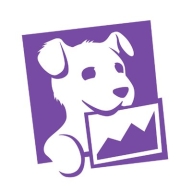

Datadog and BigPanda compete in the field of IT monitoring solutions. Datadog appears to have the upper hand with its extensive integration capabilities, while BigPanda stands out in automation, particularly in incident management.
Features: Datadog offers a robust ecosystem of integrations with tools like Amazon ECS and Kubernetes, excellent dashboards for visualization, and a hosted infrastructure that simplifies management. BigPanda excels with automation in event correlation, incident management for reducing noise, and a centralized console for monitoring integration.
Room for Improvement: Datadog users would like to see improvements in cost transparency, advanced log handling, and AI features. Technical support accessibility is also a concern. BigPanda could enhance its event correlation and dashboard capabilities for better insights, improve usability, and strengthen integrations with tools like Dynatrace.
Ease of Deployment and Customer Service: Datadog supports Public Cloud, Private Cloud, and Hybrid Cloud deployments, offering diverse infrastructure flexibility. Its customer service is generally responsive and knowledgeable. BigPanda primarily focuses on Public Cloud deployments, with excellent customer service and proactive support, though faster responses would be appreciated.
Pricing and ROI: Datadog is seen as a premium option with a usage-based billing model that requires careful management to avoid unexpected costs. Despite this, it offers high ROI for larger deployments by eliminating the need for multiple third-party solutions. BigPanda provides a budget-friendly option for high-growth companies with flexible pricing, praised for quick issue resolution contributing to a favorable return on investment.
BigPanda saves time with its advanced features and manages large environments while requiring fewer resources compared to our previous tool, Netcool.
BigPanda offers significant time-saving, cost-saving, and resource-saving benefits.
Their collaboration was good, and I would rate them nine out of ten.
For technical support, we have only had to address password resets and alert mismatching.
They are generally fast with their responses, although there might be some delays when escalating to the next level.
It handles large volumes of alerts without limitations.
We manage a large environment with over 50,000 servers and various monitoring tools like Dynatrace, New Relic, Splunk, Nagios, and Datadog.
I rate the scalability of BigPanda at eight.
I would rate the availability of BigPanda at nine because it's almost 99.99% available.
BigPanda is now stable.
However, when handling critical traffic, the BigPanda site can slow down, which we manage with a load balancer.
A 'deep dive' analysis feature would be appreciated to give detailed insights such as CPU usage and disk space analysis.
It would be beneficial if BigPanda leveraged AI to solve critical issues related to editing and sending alerts based on enrichment mapping files.
I am not sure if we can pull reports of bulk incidents in different formats like PDF, Excel, or CSV.
The documentation is adequate, but team members coming into a project could benefit from more guided, interactive tutorials, ideally leveraging real-world data.
There should be a clearer view of the expenses.
The pricing for BigPanda is reasonable compared to other event management tools, given its advantages.
The setup cost for Datadog is more than $100.
Its automation has significantly improved incident response times, reducing the process to within one minute.
BigPanda improves service reliability with instant resolution, increased uptime, and reduced mean time to resolution, thus enhancing service quality.
The platform's AI analyzes alert sources and root causes, enhancing real-time incident management and enabling automated resolution.
Our architecture is written in several languages, and one area where Datadog particularly shines is in providing first-class support for a multitude of programming languages.
The technology itself is generally very useful.


BigPanda Autonomous Operations platform is a cutting-edge solution that helps IT Ops, NOC and DevOps teams detect, investigate, and resolve IT incidents faster and more easily than ever before. Powered by Open Box Machine Learning, BigPanda correlates IT noise into insights, automates incident management, and unifies fragmented IT operations.
BigPanda’s Autonomous Operations platform increases the ease with which IT administrators are able to both manage their systems and respond to issues that arise. It combines machine learning and automation, which not only provide administrators with reliable suggestions concerning future issues that may arise, but also allows for certain tasks to be assigned to the system itself. These allow organizations to save both time and resources that can be dedicated to more critical tasks.
BigPanda’s Autonomous Operations platform possesses a simplified and unified user interface, enabling users to manage the solution from one place. The UI allows users to view and manage all of the information and controls that IT teams need to be able to easily access, providing a level of visibility that ensures users will be able to view all of their system’s most up-to-date and critical information at any time that they wish.
Benefits of BigPanda Autonomous Operations Platform
Some the benefits of using BigPanda’s Autonomous Operations platform include:
Reviews from Real Users
BigPanda’s Autonomous Operations platform stands out among its competitors for a number of reasons. Two major ones are its centralized user interface and its ability to easily integrate with other security solutions. The centralized UI gives users the ability to clearly see all their alert data in a single location without having to search for it. Its easy integration allows administrators to augment their IT security capabilities when they find it necessary to do so.
PeerSpot user Larry C., the principal engineer in charge of site operations for a tech vendor, notes this benefit when he writes, "Alert aggregation was the primary requirement. BigPanda pulls all this together into a single UI for us, allowing us to see related alerts grouped together into an incident, and enables us to easily create a JIRA ticket and Slack channel to manage an issue."
Another PeerSpot user, who is an independent entrepreneur in the IT environment at a tech services company, notes the flexibility of this platform when they write “BigPanda integrates well with other solutions, such as WatchGuard.”
Datadog is a comprehensive cloud monitoring platform designed to track performance, availability, and log aggregation for cloud resources like AWS, ECS, and Kubernetes. It offers robust tools for creating dashboards, observing user behavior, alerting, telemetry, security monitoring, and synthetic testing.
Datadog supports full observability across cloud providers and environments, enabling troubleshooting, error detection, and performance analysis to maintain system reliability. It offers detailed visualization of servers, integrates seamlessly with cloud providers like AWS, and provides powerful out-of-the-box dashboards and log analytics. Despite its strengths, users often note the need for better integration with other solutions and improved application-level insights. Common challenges include a complex pricing model, setup difficulties, and navigation issues. Users frequently mention the need for clearer documentation, faster loading times, enhanced error traceability, and better log management.
What are the key features of Datadog?
What benefits and ROI should users look for in reviews?
Datadog is implemented across different industries, from tech companies monitoring cloud applications to finance sectors ensuring transactional systems' performance. E-commerce platforms use Datadog to track and visualize user behavior and system health, while healthcare organizations utilize it for maintaining secure, compliant environments. Every implementation assists teams in customizing monitoring solutions specific to their industry's requirements.
We monitor all IT Infrastructure Monitoring reviews to prevent fraudulent reviews and keep review quality high. We do not post reviews by company employees or direct competitors. We validate each review for authenticity via cross-reference with LinkedIn, and personal follow-up with the reviewer when necessary.